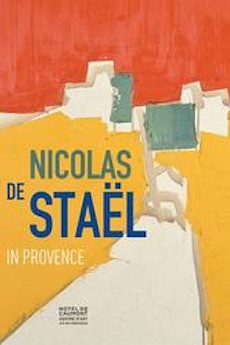By Svetlana Alpers
Nicolas de Staël (1914-1955) was one of the finest major minor masters of twentieth century painting. An interest of his painting is that it exists at the cusp, as it were, of representation and abstraction. It is painting which makes one question the value of the distinction between realism and abstraction.
This book is a catalogue of an exhibition at the Museé Caumont in Aix en Provence during the summer 2018. The exhibition (I was there and saw it) was disappointing. There were a few marvelous exceptions, but the huge burst of pictorial activity in the south of France in 1953-54 petered out as one watched it on the walls. Why?
De Stael’s life is the stuff of romance and tragedy. He was born to minor nobility in St. Petersburg, fled the revolution with his parents to Poland, and when orphaned, ended up with a family in Brussels. His life as a painter was in France. He began to achieve recognition in Paris after WW II. In March 1953, he had an exhibition with Knoedler in New York; in the fall they offered him a contract. He settled into Provence, buying a bastide in Menerbes, where Picasso bought a house for Dora Maar in 1944. He had a lover, travelled with everyone to Sicily, Naples, Rome, and sent his wife and children back to Paris. De Staël needed and loved women. Knoedler was selling and wanted more works. He felt rushed in his painting. And he himself rushed about, which was always his way. He had a burst of painting living in the south of France 1953-4 (the subject of this book) and committed suicide in 1955, age forty-one. The achievement of his brief life is astonishing. Behind this exhibition there are surviving members of his family who keep the flame burning. One may believe, as I do, that art stands alone, separate from the maker’s life, but that was not de Staël’s way.
The best of the 1953 paintings are small scale landscapes.One might describe them as intimate. They are haunting in their compressed apprehension of the light and shapes of Provence—a hard task to accomplish after Cézanne, from whose work they differ due to the character of de Staël’s feel for abstraction. He employs the same distinctive, firm, awkwardly-shaped brush strokes to render flowers in a pot, peppers on a table, or a few cypress trees standing alone. While with Cézanne one senses that he discovers structures in the world, de Staël seems more in the process of imposing them on it. His is an act of the imagination. Though referring to nature he does not, like Cézanne, claim to work from it. The paintings he made in memory of Sicily (where he swam but did not paint) lack the impasto essential, perhaps, to his painterly vision. They are weaker as a result. And that manner continues in his later landscape attention to Martigues, near Marseille, and to Marseille itself. His female nudes speak more of lived passion than of a painted one.
There was an elevated desperation about de Staël that emerges in the accounts given in this catalogue by those close to him. His paintings deserve to be looked at slowly, on their own, which the reproductions in this book enable you to do. Oh, but it would be wonderful to have one to look at on a wall.
Reviewer Svetlana Alpers, an artist, critic, and renowned art historian, is professor emerita of the history of art at the University of California, Berkeley and a visiting scholar in the Department of Fine Arts at New York University.




